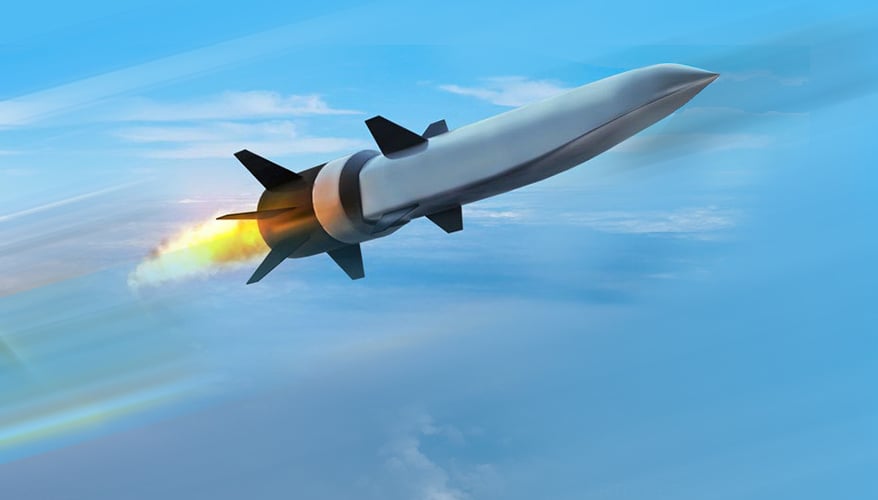
Raytheon Hypersonic cruise missile image
PENTAGON: In a memo sent Friday to the entire Navy, acting Navy Secretary Thomas Modly compared the development of hypersonic weapons by China and Russia to the “Sputnik Moment” of 1957, outlining a schedule for the Navy to conduct its next experiment on its hypersonic glide body technology.
The memo, Modly’s ninth “Vector” sent weekly to the entire force, says “this historic hindsight should heighten our awareness that major technological breakthroughs such as hypersonic weapons can destabilize the global security environment and pose an existential threat to our nation.”
To keep pace, Modly said the Navy will conduct a flight experiment later this year to demonstrate the Hypersonic Glide Body.
The Pentagon’s hypersonic research has been shrouded in some mystery as the military and defense industry rush to keep abreast of advancements Chinese and Russian leaders have boasted of in recent months.
Modly writes that, after the Sputnik launch, the United States “increased sponsored research and development spending to a height of 3.6 percent of GDP in 1965,” followed by the development of three generations of intercontinental ballistic missiles between 1957 and 1962.
That kind of quick turnaround is virtually impossible in today’s defense acquisition circles, where it takes years to get even the most uncontroversial program off the ground. Given the flat defense budget set to be unveiled next month, and the promise of little to no growth in upcoming budgets given the spiraling national debt, Modly’s incantation of the growth in research budgets is sure to strike a chord inside the Pentagon, where service squabbling over individual slices of the pie have already begun.
The Navy is also kicking off a study on “refining future basing strategies and launch platform options” for hypersonic weapons that will be ready by the time the fiscal year 2022 budget is submitted in early 2021, “clearly marking our path to achieving greater hypersonics tube inventories in the fleet.”
Navy leadership has in recent months floated the idea of incorporating conventional prompt strike weapons aboard Arleigh Burke and Zumwalt-class destroyers.
“Possible applications of hypersonic technologies have already changed the nature of the battlespace, much as nuclear technology did in the past century,” Modly wrote. “That is why when it comes to hypersonic weapons, our command today must be ‘All Ahead Full.’”
Overall, the DoD’s proposed budget through fiscal 2024 calls for over $10 billion in hypersonic weapons development, with the Air Force and Army also pushing technologies ahead as quickly as possible.
Speaking with reporters at the Center for Strategic and International Studies this week, Defense Secretary Mark Esper said the DoD “nearly doubled its long-term investment — almost $5 billion more in FY 2020 — in hypersonics alone in the next five years. And our 2021 budget will be even stronger.”
Over the past year, Russian leader Vladimir Putin has boasted of the operational deployment of Russia’s Avangard hypersonic glide vehicle, while China has said its Starry Sky-2 hypersonic glide vehicle is capable of evading US missile defense systems. It’s unclear how much of that is true, but they two countries have clearly invested heavily in the technology, alarming US and NATO military planners.
In the 2020 budget passed in December, Congress allocated $100 million to stand up a Joint Hypersonics Transition Office to pursue an “integrated science and technology roadmap for hypersonics” pulling in universities and other research institutes to push research.
Given the Chinese and Russian interest in the technology, the Missile Defense Agency is also moving out quickly. In December, the MDA held a closed-door meeting at its Alabama headquarters with defense industry reps to hash out ideas for how to knock hard-to-kill hypersonic missiles out of the sky. The classified meeting was a first step in laying out basic requirements for what’s being called the Hypersonic Defense Regional Glide Phase Weapon System.
The Senate in December also approved $230 million to accelerate hypersonic defense programs in the defense bill President Trump eventually signed. Senate and House appropriators also added $108 million to MDA’s request to pursue a “Hypersonic and Ballistic Tracking Space Sensor (formerly Space Sensor Layer).” Outside of the MDA, the Defense Advanced Research Projects Agency has been developing its Glide Breaker project, focusing heavily on a hard-kill interceptor to knock the speedy weapons out of the sky.
The Navy also said last year that it is refitting its decades-old China Lake weapons testing and research site in the Mojave Desert to begin hosting hypersonic weapons testing from a variety of platforms, including undersea launchers.
Iran says it shot down Israel’s attack. Here’s what air defense systems it might have used.
Tehran has been increasingly public about its air defense capabilities, including showing off models of systems at a recent international defense expo.


























